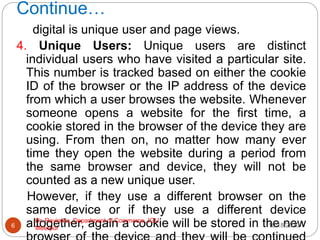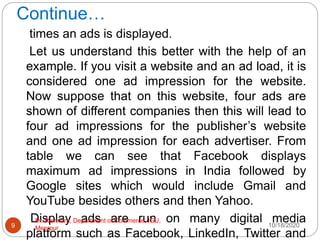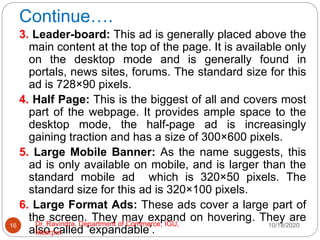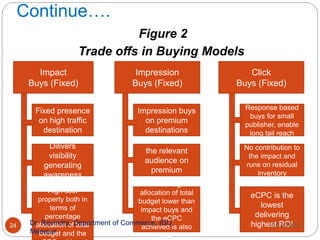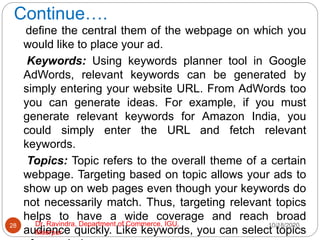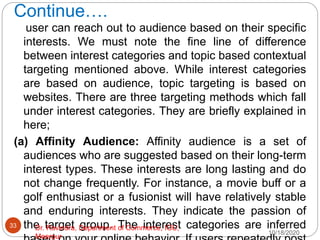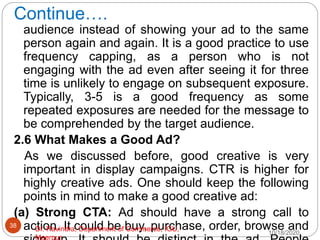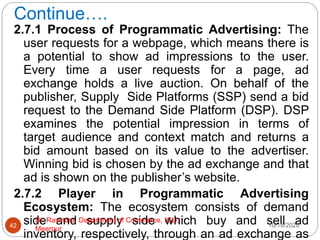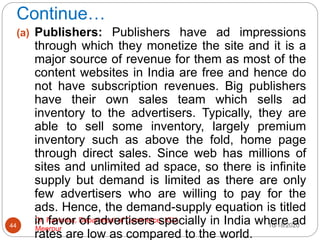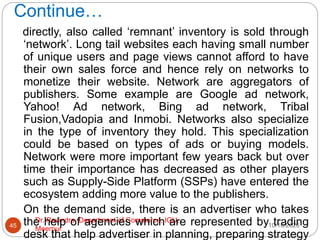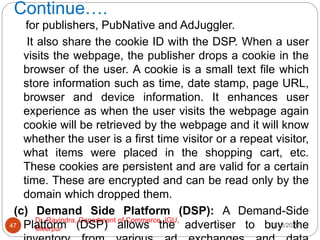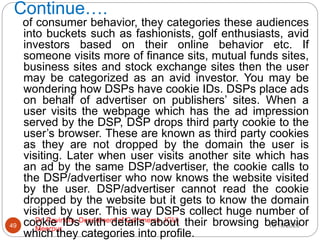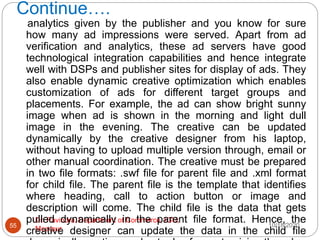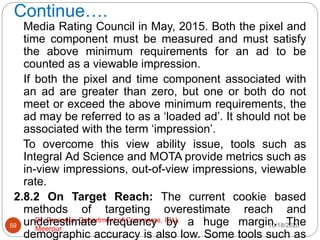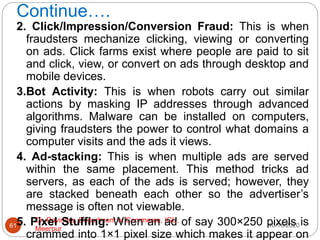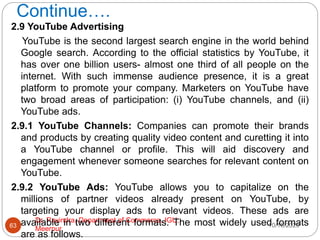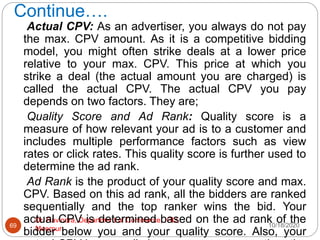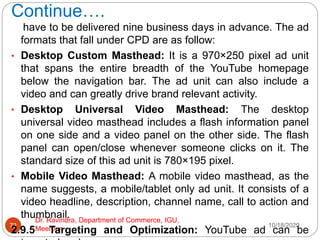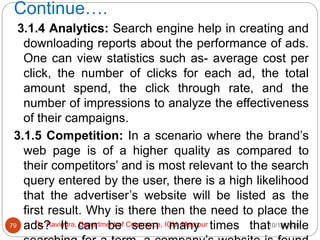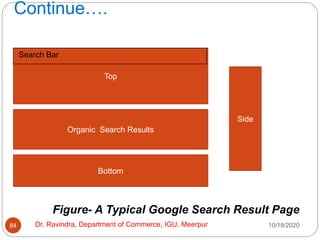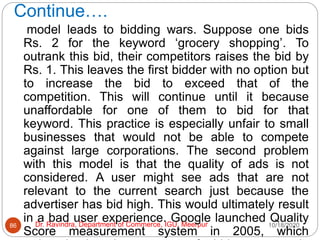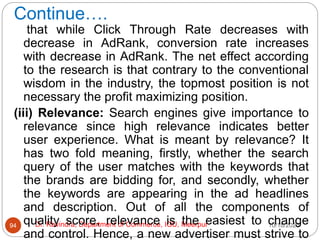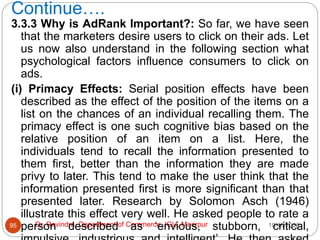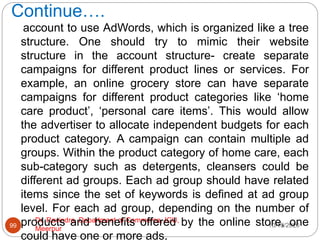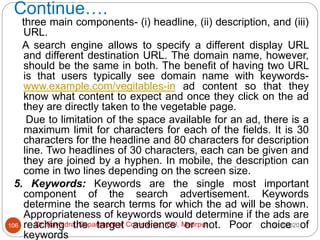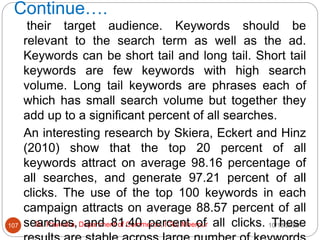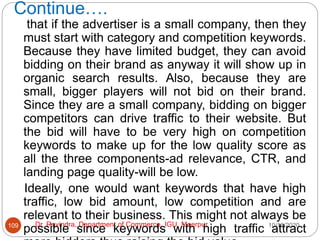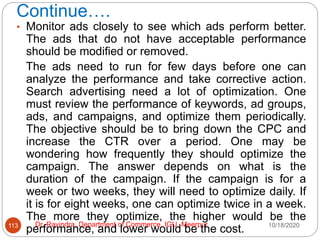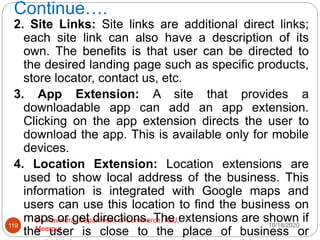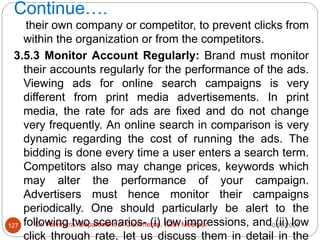Digital marketing ppt 2 unit
- 1. Dr. Ravindra Assistant Professor Department of Commerce Indira Gandhi University, Meerpur, Rewari Digital Marketing Unit-2
- 2. Display Advertising Introduction: Picture superiority Effect (PSE) is a phenomenon which drives display advertising. According the PSE, the human brain is more likely to remember images and pictures than words. This phenomenon is used in many aspects of everyday life which involve communication, and display advertising is one such key application. It is the art of communicating your message using attractive creative and images which help in better recall. The emergence of internet as the zero moment of truth has made it vital for companies to have a good digital presence. Consumers search on the internet before purchasing the product. Companies (Ford NewZealand) noticed this trend in early 2014 and decided to bolster its online customer experience to 10/18/2020 2 Dr. Ravindra, Department of Commerce, IGU, Meerpur
- 3. Continue…. The company developed interactive display banners and coupled them with tailor made content aimed at engaging with customers across different websites. It used Google Display Networks (GDN) to channel all its online resources towards driving prospective customers to showrooms. Further, Ford also created a new website with structured information and visually appealing images about all its cars and marketed it to its targeted audience. This entire exercise yield great results for Ford. 2.1 Concept of Display Advertising Display advertising refers to the act of communicating the advertising message using visually rich media. The main objective of display 10/18/2020 3 Dr. Ravindra, Department of Commerce, IGU, Meerpur
- 4. Continue…. websites with huge traffic to reach maximum users. The mode of communication may be through traditional media or digital media. Traditional media includes print (newspapers, magazines, pamphlets, journals etc.) and television. Display ads can be either native or non-native. In native advertising, the ad content and outlook is native to the environment of the page on which it is being displayed. Unlike banner ads which are easily identifiable and differentiable, native ads are not easily differentiable as they blend well with the content of the page, its environment and context. 2.1.1 Display Advertising Media Do you know that ads on TV and print are also a 10/18/2020 4 Dr. Ravindra, Department of Commerce, IGU, Meerpur
- 5. Continue…. most important requirement is ‘Reach’. The metrics for measuring the reach is different in different mediums of display advertising. Each of these modes has its own set of pro and cons. 1. Print Media: Print media is the most traditional mode of communication and has been there for several years. The metric for measuring the reach in print media is the circulation or number of readers. 2. Television: Television advertising has video content and has better engagement rate than the print media. The metric for measuring the reach in TV is the number of viewers. 3. Digital: Display advertisement include ads served 10/18/2020 5 Dr. Ravindra, Department of Commerce, IGU, Meerpur
- 6. Continue… digital is unique user and page views. 4. Unique Users: Unique users are distinct individual users who have visited a particular site. This number is tracked based on either the cookie ID of the browser or the IP address of the device from which a user browses the website. Whenever someone opens a website for the first time, a cookie stored in the browser of the device they are using. From then on, no matter how many ever time they open the website during a period from the same browser and device, they will not be counted as a new unique user. However, if they use a different browser on the same device or if they use a different device altogether, again a cookie will be stored in the new 10/18/2020 6 Dr. Ravindra, Department of Commerce, IGU, Meerpur
- 7. Continue…. 5. Page Views v/s Unique Visitors: Page views and unique visitors both are equally important for the long term growth of any website. If asked to choose one, you should choose based on the type of website you are running, your digital marketing goals for the moment and the phase in which your company is. If you are a publisher or a blog and in the phase of increasing your revenue, then page views are more important as they contribute towards more ads being displayed to the audience and in turn generate revenue. On the other hand, if you are a product company and looking for brand building, and then Unique Visitors are important for you because, no matter which page 10/18/2020 7 Dr. Ravindra, Department of Commerce, IGU, Meerpur
- 8. Continue…. The sources of such data are third party companies such as ComScore which have a panel of more than two million users in India who agree to get their online behavior tracked in exchange for some freebies. This data is then extrapolated for different customer segments. This data is used to identify the passion points or genres that the target audience is interested in and the website frequently visited by the target audience. The data can also indicate how much duplication is there and how much will be the unique reach. Based on this data, marketer can choose the websites where they want to run display ads and prepare a display media plan. 2.1.2 Digital Metrics 1. Ad Impression: An ad impression is recorded whenever an ads is displayed on the user’s screen 10/18/2020 8 Dr. Ravindra, Department of Commerce, IGU, Meerpur
- 9. Continue… times an ads is displayed. Let us understand this better with the help of an example. If you visit a website and an ad load, it is considered one ad impression for the website. Now suppose that on this website, four ads are shown of different companies then this will lead to four ad impressions for the publisher’s website and one ad impression for each advertiser. From table we can see that Facebook displays maximum ad impressions in India followed by Google sites which would include Gmail and YouTube besides others and then Yahoo. Display ads are run on many digital media platform such as Facebook, LinkedIn, Twitter and 10/18/2020 9 Dr. Ravindra, Department of Commerce, IGU, Meerpur
- 10. Continue…. Table: Top 10 Publisher in India rank by Desktop Display Ad Impression (In Millions) Publisher Desktop Display Ad Impression %of Total 1. Facebook 5,337 26.7 2. Google Site 2,403 12.0 3. Yahoo Site 2,373 11.9 4. Rediff.com 696 3.5 5. Microsoft site 688 3.4 6. Time Internet 633 10/18/2020 10 Dr. Ravindra, Department of Commerce, IGU, Meerpur
- 11. Continue…. 2. Clicks: A click is counted whenever a user click on an ad. upon clicking, it redirects the user to the landing page. 3. Click Through Rate (CTR): Click through rate (CTR) is the total number of clicks divided by the total number of impressions. CTR is often expressed as a percentage. Mathematically; Click Click Through Rate (CTR) = × 100 Impression CTR is an important metric in deciding the effectiveness of an ad. Ads with low CTRs should be modified to improve. Low CTRs imply that most of the users are ignoring the ad after seeing it. In such cases, three factors are to be checked 10/18/2020 11 Dr. Ravindra, Department of Commerce, IGU, Meerpur
- 12. Continue…. a. Category: The product category for which the ad is being displayed is an important factor to decide the optimal CTR. Product categories such as automobiles, mobile phones, etc. generally tend to have higher Click Through Rates when compared to categories such as grocery, cosmetics, B2B products/services etc. It is because these categories are high-involvement, requiring users to do more research before buying and even if the user is not in the market to buy the product or service, the interest in these categories is high and hence the chances of users clicking on ads is higher. b. Creative: Eye catching creative banners are the heart and soul of display advertising. Creativity in design may include using rich audio visual media, 10/18/2020 12 Dr. Ravindra, Department of Commerce, IGU, Meerpur
- 13. Continue…. c. Placement: A beautifully designed ad placed at the wrong place might not yield results as expected. Placement is as important as creativity. For example, the ad about weight loss, if placed on a car review portal will not deliver results. Selecting the right category of websites to advertise is critical to success. While selecting the category, you should make sure most of your target audience are available on these websites. More about the various targeting strategies has been covered later. 2.2 Types of Display Ads Display ads can be classified into different types based on two factors, namely size and format. 2.2.1 Format 10/18/2020 13 Dr. Ravindra, Department of Commerce, IGU, Meerpur
- 14. Continue…. 1. Image Ads: Image ads contain static images related to your product or service. They have no effects and are the most standard format of advertising. 2. Rich Media Ads: Rich media ads include other interactive media elements such as animations, GIFs or other dynamic aspects which change upon user interaction. For example, ads which you can interact with as you hover on them or scroll down. A classical example of a rich media ad is a page peel ad, where in, when you click on the slightly peeled off part on the top right, the ad appears as the page peels off completely. 3. Video Ads: Video ads are those in which a video is embedded in the ad. This format of advertising is extensively used in YouTub. It is highly effective and 10/18/2020 14 Dr. Ravindra, Department of Commerce, IGU, Meerpur
- 15. Continue…. 2.2.2 Display Ads Size Display ads are put up in various sizes based on the availability of space on the website. The most popular, top performing and standardized ad sizes are described in this section. 1. Medium Rectangle: Available both in the desktop and mobile platform, the medium rectangle ad is the most popular display ad. The content could include text, images or other animation. The ad size is 300 (width)×250 (height) pixels. 2. Large Rectangle: Large rectangle has more ad space when compared to the medium rectangle and thus can be used to communicate better. This ad is only available in the desktop mode. 10/18/2020 15 Dr. Ravindra, Department of Commerce, IGU, Meerpur
- 16. Continue…. 3. Leader-board: This ad is generally placed above the main content at the top of the page. It is available only on the desktop mode and is generally found in portals, news sites, forums. The standard size for this ad is 728×90 pixels. 4. Half Page: This is the biggest of all and covers most part of the webpage. It provides ample space to the desktop mode, the half-page ad is increasingly gaining traction and has a size of 300×600 pixels. 5. Large Mobile Banner: As the name suggests, this ad is only available on mobile, and is larger than the standard mobile ad which is 320×50 pixels. The standard size for this ad is 320×100 pixels. 6. Large Format Ads: These ads cover a large part of the screen. They may expand on hovering. They are also called ‘expandable’. 10/18/2020 16 Dr. Ravindra, Department of Commerce, IGU, Meerpur
- 17. Continue…. ad spaces on a page. It is also called Roadblock which is popular in newspaper advertising too. The objective is to ensure that users do not miss the ad and get exposed to the brand. 2.3 Buying Models There are mainly four different pricing models for display ads. The user has to carefully decide which model is most appropriate for him/her based on the campaign goals. 1. Cost Per Click (CPC): Cost Per Click (CPC) is the amount the users are willing to pay for a click on their ads. CPC is used solely to drive traffic to the advertiser’s website. They are comparatively less risky because, as an advertiser you only must 10/18/2020 17 Dr. Ravindra, Department of Commerce, IGU, Meerpur
- 18. Continue…. 2. Cost Per Milli (CPM): Cost Per Milli, also known as the cost per thousand impressions, is the amount the advertiser must pay for every thousand impression served. The CPM model is mainly used for brand building purposes. It ensures your ad reaches a wide range of audience but does not necessarily drive traffic to your website. This model is preferred by publishers as they get paid irrespective of clicks and enables better cash flow projections for them. CPC v/s CPM CTR is an important factor to be considered in order to determine the better of the two; CPC and CPM. If you have a high CTR, simply displaying your ads on a website might suffice for you because the audiences are clicking on ads. On the contrary, if people are not 10/18/2020 18 Dr. Ravindra, Department of Commerce, IGU, Meerpur
- 19. Continue…. after continuous efforts, then you may consider the CPC model. You can also calculate effective CPC even if you are bidding on CPM model and then compare. Let us take an example here. Let us assume that for a publisher the CPM rates are Rs. 80 and CPC is Rs. 8. The average CTR of display ads is 0.2 percent. Considering the average CTR, the number of clicks from 1000 impressions will be 2 (1000×0.2 percent). If you buy on CPM then for 1000 impressions you get two clicks. Hence effective CPC (eCPC) is Rs. 40 which is much higher than the CPC of Rs. 8. Hence, the marketer will be better off buying on CPC in this case than 10/18/2020 19 Dr. Ravindra, Department of Commerce, IGU, Meerpur
- 20. Continue…. 3. Cost Per Lead (CPL): CPL is the amount you pay as an advertiser for acquiring a lead. Lead is an intermediate action before final purchase. It is a micro conversion. It could be a sign up, download of a brochure, subscription, etc. The objective of the marketer is to acquire leads and nurture them through continuous engagement for conversions later. 4. Cost Per Acquisition (CPA): Cost Per Acquisition (CPA) is the amount you pay, as an advertiser for acquiring a customer who buys your product or service. It typically means the cost of customer acquisition. This model is mainly used to drive online transaction and is risk free as you only pay when the user buys. The bid price is comparatively higher when compared to the other 10/18/2020 20 Dr. Ravindra, Department of Commerce, IGU, Meerpur
- 21. Continue…. eCPA may be calculated when bidding on CPC and that can be used to arrive at target CPA. Let us take an example here, assume 100 people click on your ad and land on your website. Assume that out of 100 people, 10 people fill a lead form and out of them 1 user buys. Assume that CPC is Rs. 20. What will be the target CPL and target CPA? The total cost in this case is Rs. 2000 ( 100×Rs. 20) and eCPL is Rs. 200 and eCPA is Rs. 2000. Thus marketer can now have a target CPL of less than Rs. 200 and it will be a more cost efficient model than the current CPC of Rs, 20. Similarly marketer can have a target CPA of less than Rs. 2000 and it will be more cost efficient than the current CPC of Rs. 20. 5. Fixed Cost/Sponsorship: In this model, you pay the 10/18/2020 21 Dr. Ravindra, Department of Commerce, IGU, Meerpur
- 22. Continue…. cost model. A related model is sponsorship. You can sponsor a website or a property, wherein your you have logo presence and some ad inventory as a part of the package deal. Figure 1 in next slide captures the essence of different models. As a marketer you have to strike a balance between impact, reach and cost effectiveness. Your plan must have a good mix of sites which will break the clutter and make an impact, sites that will give you reach and sites that will be cost effective. Figure 2 explains the execution and outcomes for different buying models. 10/18/2020 22 Dr. Ravindra, Department of Commerce, IGU, Meerpur
- 23. Continue…. Figure 1 Buying Models CPM CPC CPL/CPA Sponsorships •Allows planner to select best performing sites and placement •Measured in terms of Clicks, CTR •Cannot or section or placement. •Auto-runs based on inventory availability •Measured in terms of actual deliveries and cost efficiency. •Situated for sales/leads base campaign. •Measure in terms of signups achieved, cost efficiency •Long term branding initiatives •Still measured in terms of clicks, CTR 10/18/2020 23 Dr. Ravindra, Department of Commerce, IGU, Meerpur
- 24. Continue…. Figure 2 Trade offs in Buying Models Impact Buys (Fixed) Impression Buys (Fixed) Click Buys (Fixed) Fixed presence on high traffic destination Dilivers visibility generating awareness High cost property both in terms of percentage allocation of total budget and the Impression buys on premium destinations Ensure reach to the relevant audience on premium inventory Percentage allocation of total budget lower than impact buys and the eCPC achieved is also low Response based buys for small publisher, enable long tail reach No contribution to the impact and runs on residual inventory eCPC is the lowest delivering highest ROI 10/18/2020 24 Dr. Ravindra, Department of Commerce, IGU, Meerpur
- 25. Continue…. 2.4 Display Plan Marketers need to prepare a display media plan which must include the following aspects; • Site • Section • Ad size • Impression • Rate • Cost The question that arises is how to prepare a digital marketing plan? Firstly, the marketer must identify the objectives and target audience for the campaign. Then, the marketer must calculate how much is the penetration of internet among the target audience? Further, what are the passion points of target audience and which website are frequently visited by them? 10/18/2020 25 Dr. Ravindra, Department of Commerce, IGU, Meerpur
- 26. Continue…. The duplication in reach is then calculated to arrive at budget allocation to sites. Figure 3 reflect the process. Figure-3 Display Plan Process 1. Objective and TG as defined by client 2. Calculating the TG reach in Internet Universe 3. Identifying the passion points and digital hangout of the TG 4. List the genres relevant to reach the TG and top websites 5.Duplication and reach calculation for budget allocation to sites 6.Finalise plan as per reach, engageme nt and passion point This will define the media mix and the recommen ded reach What is the base of relevant audience available on Internet ComScore shows the genre where TG spends their online time based on age and Gender targeting ComScor e shows the top websites visited by the TG Duplicatio n calculatio n identifies effective reach of each site The final plan aims to reach the relevant TG at relevant touch points 10/18/2020 26 Dr. Ravindra, Department of Commerce, IGU, Meerpur
- 27. Continue… 2.5 Targeting Sophisticated targeting methods are available in display advertising. Reaching to the right audience is extremely important for the success of the display advertising campaign. This can be done efficiently by following various targeting methods as explained next. 2.5.1 Contextual Targeting: Contextual targeting delivers ads to the audience based on the content they consume. It uses ‘keywords’ or ‘tags’ added to the ads to match them to relevant websites. As a marketer, you choose the keywords and topics most relevant to your ads. Keywords are individual terms which are relevant to your 10/18/2020 27 Dr. Ravindra, Department of Commerce, IGU, Meerpur
- 28. Continue…. define the central them of the webpage on which you would like to place your ad. Keywords: Using keywords planner tool in Google AdWords, relevant keywords can be generated by simply entering your website URL. From AdWords too you can generate ideas. For example, if you must generate relevant keywords for Amazon India, you could simply enter the URL and fetch relevant keywords. Topics: Topic refers to the overall theme of a certain webpage. Targeting based on topic allows your ads to show up on web pages even though your keywords do not necessarily match. Thus, targeting relevant topics helps to have a wide coverage and reach broad audience quickly. Like keywords, you can select topics 10/18/2020 28 Dr. Ravindra, Department of Commerce, IGU, Meerpur
- 29. Continue… based on four factors: (i) text, (ii) language, (iii) link structure, and (iv) page structure. Based on these factors, Google determines the central theme of each webpage in the Google Display Network. 2.5.2 Placement Targeting: Placement targeting can be used when you have a clear idea about your audience activity on the web. You can directly choose to display your ads on websites, few web pages, videos, RSS feeds, mobile sites, etc. Further, you can also choose specific positions for your ads on the websites. This is called ‘managed placement’. You can also use a combination of contextual and placement targeting for better results. For example, if you are selling cars, as part of the placement targeting, 10/18/2020 29 Dr. Ravindra, Department of Commerce, IGU, Meerpur
- 30. Continue… you could use contextual targeting (use of keywords) to determine the exact pages in the website which are more relevant and advertise in those pages only. 2.5.3 Remarketing: One a visitor visits your website and view a product, the visitor is tracked. Later, if the visitors leave your site and visit any other site in the network they are tracked and shown a relevant ad about your product on the other site. It is similar to Face book Dynamics Advert. For example, consider your visit Flipkart and browse through a particular model of a T.V. Later, you exit Flipkart and visit some other website. Now, you are shown ads on the new website you visit, about the TV you browse through in Flipkart. This entire process is called remarketing i.e. 10/18/2020 30 Dr. Ravindra, Department of Commerce, IGU, Meerpur
- 31. Continue…. customers about your brand and the product and tries to convert them into sale. One is simple remarketing in which the creative shown is prepared beforehand and is static. In this case, you must copy paste the remarketing code on the source code of your website so that the cookie IDs of visitors to the website can be tracked. Then, you must create list for specific pages of the website such as those who abandoned the cart or those who visited specific pages of the site and then ads will be shown to them. You can also do dynamic remarketing in which different code must be pasted in source code of website so that it appears on all pages of website. This code has an additional variable known as ‘Product ID’. Additionally, you upload 10/18/2020 31 Dr. Ravindra, Department of Commerce, IGU, Meerpur
- 32. Continue…. catalogue is pulled to create a customized ad showing the same product that the user visited. The process of remarketing is shown in the figure 4. Figure-4 Prospect Returns to Your Site Prospect Your Site Prospect is Tracked Prospect Leaves Your Ad on other Sites 10/18/2020 32 Dr. Ravindra, Department of Commerce, IGU, Meerpur
- 33. Continue…. user can reach out to audience based on their specific interests. We must note the fine line of difference between interest categories and topic based contextual targeting mentioned above. While interest categories are based on audience, topic targeting is based on websites. There are three targeting methods which fall under interest categories. They are briefly explained in here; (a) Affinity Audience: Affinity audience is a set of audiences who are suggested based on their long-term interest types. These interests are long lasting and do not change frequently. For instance, a movie buff or a golf enthusiast or a fusionist will have relatively stable and enduring interests. They indicate the passion of the target group. The interest categories are inferred 10/18/2020 33 Dr. Ravindra, Department of Commerce, IGU, Meerpur
- 34. Continue…. once you inter your website URL, Google determines the relevant affinity audience. On the other hand, if you are a comparatively new startup and expect that lot of your prospective customers are available on an e-commerce portal, and then you can still choose the affinity audience of that portal to market your product. Further, you can even get insights about the demographics of the audience in the interest category you select. (b) Custom Affinity Audience: One can choose to build his/her own category of audience, called the custom affinity audience. Here, a combination of keywords and website URLs can be used to describe the category requirement. Based on 1 10/18/2020 34 Dr. Ravindra, Department of Commerce, IGU, Meerpur
- 35. Continue…. powerful method of targeting as it is completely customized and one can target users interested in competition. (c) In-Market Audience: In-market audience are those who are presently engaged in the market i.e., they are actively researching a product or a service in the market and are most likely to buy it soon. Google displays these audiences, sorted according to various categories of products and services to which they belong. This targeting method is for those advertisers who advertise for generating sales revenues. If you are running performance campaigns then this method is appropriate. 10/18/2020 35 Dr. Ravindra, Department of Commerce, IGU, Meerpur
- 36. Continue…. on their geographic location. Google allows you to target users based on countries, areas within a country, radius around a location, group of locations, etc. You can also target location by places of interest or a postal code. Further, Google allows you to target bulk locations (up to 1000 locations) at once, instead of selecting locations one by one. Some of these are not available for India yet. Language targeting is the act of targeting people based on the language they speak. 2.5.6 Demographics: Demographic targeting can be used to target people based on demographic factors such as age, gender, parental status, household income etc. This type of targeting helps you narrow your targeting and prevent your ads from reaching inappropriate audience. 1 0/18/2020 36 Dr. Ravindra, Department of Commerce, IGU, Meerpur
- 37. Continue…. If you wish to show more ads on mobile then you can increase the bid for mobile by a certain percent. Alternatively, if you do not wish to show your ad on desktop then you can decrease the bids for desktop. 2.5.8 Other Targeting Methods Ad Scheduling: Ad scheduling allows you to run ads during a specific time of the day or during specific days of the week. For example, order for online grocery is placed more on weekends and in evenings hence you might want to run your ads only from 5 p.m. to 9 p.m. on Friday, Saturday and Sunday, if you have limited budget. Frequency Capping: Frequency capping sets an upper limit on the number of times a person sees 10/18/2020 37 Dr. Ravindra, Department of Commerce, IGU, Meerpur
- 38. Continue…. audience instead of showing your ad to the same person again and again. It is a good practice to use frequency capping, as a person who is not engaging with the ad even after seeing it for three time is unlikely to engage on subsequent exposure. Typically, 3-5 is a good frequency as some repeated exposures are needed for the message to be comprehended by the target audience. 2.6 What Makes a Good Ad? As we discussed before, good creative is very important in display campaigns. CTR is higher for highly creative ads. One should keep the following points in mind to make a good creative ad: (a) Strong CTA: Ad should have a strong call to action. It could be buy, purchase, order, browse and 10/18/2020 38 Dr. Ravindra, Department of Commerce, IGU, Meerpur
- 39. Continue…. and what to expect. (b) Include Price: If price is your advantage, you may wish to include price in the ad. Another benefit is that you will get only relevant clicks. If your buying model is CPC and if users find your price high then they will not click on your ad and you do not have to pay for their clicks. (c) Aesthetics: Experiment with fonts, images, colors. It is more important to match the sites that you’re targeting in color schemes, than to match your landing page. It is a good idea to include text in your image ad as it induces people to click. Use attractive images. (d) Unique Selling Proposition: Communicate one unique benefit strongly. Keep it simple and do not 10/18/2020 39 Dr. Ravindra, Department of Commerce, IGU, Meerpur
- 40. Continue… (e) Show Two Ads With Two Offers to the Target Audience: For example, one ad with free e-book and another for price off. If you do not have two offers then make two ads of the same offer. 2.7 Programmatic Digital Advertising Programmatic advertising is automated ad buying. The buying takes place in real time and follows a bidding model. Hence, it is called Real Time Bidding (RTB) model. Bidding here takes place for ad spaces in the publisher’s web pages. Programmatic advertising is the most recent development related to automation in the field of display advertising. Programmatic buying signifies the shift from contextual targeting to audience 10/18/2020 40 Dr. Ravindra, Department of Commerce, IGU, Meerpur
- 41. Continue… you are a car brand. Contextual advertising mean advertising on car portals such as Team-BHP, Autocar India, etc. Instead, advertiser can target audiences who may be defined as those who have visited car portal at least once in the last one month, visited finance site at least once in the last one month and booked a travel ticket online at least once in the last one month. This user is more likely to buy a car. It does not matter on which site the user sees the ad. This is called audience targeting which is based on online behavior. It infers intent of the user and target based on intent buying. Programmatic buying reaches the right audience at the right time and place at the right 10/18/2020 41 Dr. Ravindra, Department of Commerce, IGU, Meerpur
- 42. Continue…. 2.7.1 Process of Programmatic Advertising: The user requests for a webpage, which means there is a potential to show ad impressions to the user. Every time a user requests for a page, ad exchange holds a live auction. On behalf of the publisher, Supply Side Platforms (SSP) send a bid request to the Demand Side Platform (DSP). DSP examines the potential impression in terms of target audience and context match and returns a bid amount based on its value to the advertiser. Winning bid is chosen by the ad exchange and that ad is shown on the publisher’s website. 2.7.2 Player in Programmatic Advertising Ecosystem: The ecosystem consists of demand side and supply side which buy and sell ad inventory, respectively, through an ad exchange as 10/18/2020 42 Dr. Ravindra, Department of Commerce, IGU, Meerpur
- 43. Continue…. Figure-5 Players in Programmatic Advertising Ecosystem 11. Third Party 12. Consumer 1.Advertis er 2.Agenc y 3.DS P 7.Publish er 6. Networ kk 5.SS P 4. Exchang e 10. Data Aggregators 8. Data 9. Data 10/18/2020 43 Dr. Ravindra, Department of Commerce, IGU, Meerpur
- 44. Continue… 10/18/2020 Dr. Ravindra, Department of Commerce, IGU, Meerpur 44 (a) Publishers: Publishers have ad impressions through which they monetize the site and it is a major source of revenue for them as most of the content websites in India are free and hence do not have subscription revenues. Big publishers have their own sales team which sells ad inventory to the advertisers. Typically, they are able to sell some inventory, largely premium inventory such as above the fold, home page through direct sales. Since web has millions of sites and unlimited ad space, so there is infinite supply but demand is limited as there are only few advertisers who are willing to pay for the ads. Hence, the demand-supply equation is titled in favor of advertisers specially in India where ad rates are low as compared to the world.
- 45. Continue… 10/18/2020 Dr. Ravindra, Department of Commerce, IGU, Meerpur 45 directly, also called ‘remnant’ inventory is sold through ‘network’. Long tail websites each having small number of unique users and page views cannot afford to have their own sales force and hence rely on networks to monetize their website. Network are aggregators of publishers. Some example are Google ad network, Yahoo! Ad network, Bing ad network, Tribal Fusion,Vadopia and Inmobi. Networks also specialize in the type of inventory they hold. This specialization could be based on types of ads or buying models. Network were more important few years back but over time their importance has decreased as other players such as Supply-Side Platform (SSPs) have entered the ecosystem adding more value to the publishers. On the demand side, there is an advertiser who takes the help of agencies which are represented by trading desk that help advertiser in planning, preparing strategy
- 46. Continue… 10/18/2020 Dr. Ravindra, Department of Commerce, IGU, Meerpur 46 audience and goals. For example, whether bidding should be on CPM or CPC or CPA model; or whether the goal should be to maximize reach or impressions or clicks; and what should be the target audience. (b) Supply-Side Platform (SSP): A supply-Side Platform or Sell-Side Platform (SSP) is a technology platform which enables the publishers to manage their ad impression inventory and maximize from digital media. SSP is a yield manager of the publisher. It maximizes the yield for publishers by selling impressions for as much CPM as possible. It integrates multiple network together. It share the context of the webpage, such as topic, keywords, page URL and the profile of the user such as demography, location, device and browser behavior with the DSP and requests the DSP to bid for ad impression. Some of the SSPs are LiveRail,
- 47. Continue…. 10/18/2020 Dr. Ravindra, Department of Commerce, IGU, Meerpur 47 for publishers, PubNative and AdJuggler. It also share the cookie ID with the DSP. When a user visits the webpage, the publisher drops a cookie in the browser of the user. A cookie is a small text file which store information such as time, date stamp, page URL, browser and device information. It enhances user experience as when the user visits the webpage again cookie will be retrieved by the webpage and it will know whether the user is a first time visitor or a repeat visitor, what items were placed in the shopping cart, etc. These cookies are persistent and are valid for a certain time. These are encrypted and can be read only by the domain which dropped them. (c) Demand Side Platform (DSP): A Demand-Side Platform (DSP) allows the advertiser to buy the
- 48. Continue…. 10/18/2020 Dr. Ravindra, Department of Commerce, IGU, Meerpur 48 RTB. The DSP present the interest of the advertiser and attempt to find the most efficient impressions given the constraints imposed by the advertiser. They optimize the campaign for a pre defined strategy which includes goals, whether maximize clicks or impressions, return on ad spend, budget, target audience and bid strategy. Most of the DSPs work on CPM model but in future we will see other buying models too through DSPs. Some of the DSP companies are Double click, and Audience science. DSP get the request for bid from SSP which include the cookie ID of the user who is requesting the webpage. DSPs have audiences which are
- 49. Continue…. 10/18/2020 Dr. Ravindra, Department of Commerce, IGU, Meerpur 49 of consumer behavior, they categories these audiences into buckets such as fashionists, golf enthusiasts, avid investors based on their online behavior etc. If someone visits more of finance sits, mutual funds sites, business sites and stock exchange sites then the user may be categorized as an avid investor. You may be wondering how DSPs have cookie IDs. DSPs place ads on behalf of advertiser on publishers’ sites. When a user visits the webpage which has the ad impression served by the DSP, DSP drops third party cookie to the user’s browser. These are known as third party cookies as they are not dropped by the domain the user is visiting. Later when user visits another site which has an ad by the same DSP/advertiser, the cookie calls to the DSP/advertiser who now knows the website visited by the user. DSP/advertiser cannot read the cookie dropped by the website but it gets to know the domain visited by user. This way DSPs collect huge number of cookie IDs with details about their browsing behavior which they categories into profile.
- 50. Continue…. 10/18/2020 Dr. Ravindra, Department of Commerce, IGU, Meerpur 50 SSP. DSP check its cookie database for users who are visiting the publisher’s website. It may realize that both DSP cookie ID 10 and SSP cookie ID 20 belong to the same user 123. In that case match has been found between cookies IDs of SSP and DSP and hence DSP will bid. If it is winning bid then ad will be pushed from the third party ad server to the publisher site. If cookie syncing happens then bid rate will be high but if cookie does not match then bid rates may fall as DSP may bid based on contextual factors and not audience factors or DSP may decide not to bid. Hence, there is flurry of activity for each impression. Benefits of DSP DSPs bring lot of benefits to the advertiser. Some key benefits are as under:
- 51. Continue…. 10/18/2020 Dr. Ravindra, Department of Commerce, IGU, Meerpur 51 1. Cost Efficiency: They enable buying at lower CPM as they can participate in actions when competition is less. 2. Buying Efficiency: They eliminate need for human interface and relationship and hence bring efficiency in buying. Sellers do not need to hire sales force and advertisers need not negotiate with different publishers as the entire exchange is automated. 3. Real Time Optimization: Since its highly automated metrics data comes in real time with no time lag enabling optimization of campaigns. 4. Granular Targeting: Sophisticated targeting options are available in DSP including cookie matching which ensure higher ROI. 5. Scale: For remarketing, wherein advertisers target users who visited their sites, DSPs provide reach and scale as they work with SSPs that have large number of sites.
- 52. Continue…. 10/18/2020 Dr. Ravindra, Department of Commerce, IGU, Meerpur 52 contextual targeting. Wherein advertisers target context or sites belonging to a particular topic or keyword. Each DSP interacts with more than 15 SSPs and can serve more than 15 billion impression per day. (d) Data Management Platform (DMP): A Data Management Platform (DMP) is used by publishers and buyers to store and manage audience data from multiple sources. These sources include publisher’s websites, videos etc. There are three sources of data. First party data is from sites such as Google, LinkedIn, Facebook, Yahoo! which create data as users create profiles on these platforms. Second party data is customer data which is owned by big e-commerce sites such as Amazon.com and telecom service providers such as AT&T. Third party data is from data providers such as DMPs which collect cookie based audience dat. See figure 6 in next
- 53. Continue…. 10/18/2020 Dr. Ravindra, Department of Commerce, IGU, Meerpur 53 Figure-6: Types of Data Suppliers 1St Party Data Data creation 2nd Party Data Customer Data 3rd Party Data Data Provider A company will have its own CRM or transactional data. It can make this data richer by adding a layer of public data. This can be done by checking email IDs, public profiles on Facebook, LinkedIn, Twitter, classified such as Justdial, and LinkedIn Faceboo k Google Yahoo! Datalogic, Exelate LOTAME Bluekai Audience create Amazon .com City Bank AT&T
- 54. Continue…. 10/18/2020 Dr. Ravindra, Department of Commerce, IGU, Meerpur 54 from there, filling profile information such as age, gender, job title, seniority, occupation, address, URL, contact detail etc. There are data providers who can add the social media profile to your CRM data. From DMP, you can have cookie based browsing behavior data of your CRM customers. If you integrate all these different data sources, your customer data becomes very rich and you can target them for higher ROI. DMP brings all the data sets together. For example, let us assume you sell car insurance and your CRM data shows that one of your customers is in the market to buy a home and demo data shows his high-income level, so now you can show ads for cross selling premium home insurance. To further expand your audiences, you can target ‘Lookalike Audiences’ of your best and rich customer dataset. (e) Ad Server: There are ad server technology companies
- 55. Continue…. 10/18/2020 Dr. Ravindra, Department of Commerce, IGU, Meerpur 55 analytics given by the publisher and you know for sure how many ad impressions were served. Apart from ad verification and analytics, these ad servers have good technological integration capabilities and hence integrate well with DSPs and publisher sites for display of ads. They also enable dynamic creative optimization which enables customization of ads for different target groups and placements. For example, the ad can show bright sunny image when ad is shown in the morning and light dull image in the evening. The creative can be updated dynamically by the creative designer from his laptop, without having to upload multiple version through, email or other manual coordination. The creative must be prepared in two file formats: .swf file for parent file and .xml format for child file. The parent file is the template that identifies where heading, call to action button or image and description will come. The child file is the data that gets pulled dynamically in the parent file format. Hence, the creative designer can update the data in the child file
- 56. Continue…. 10/18/2020 Dr. Ravindra, Department of Commerce, IGU, Meerpur 56 is done by ad servers. Ad servers charge a small percent of media spend for the fees. Unfortunately only 40 percent advertisers in India use third party ad servers as they consider it as cost. (f) Ad Exchange: Ad exchange brings together buyers and sellers to buy and sell online ad inventory in an automated manner. Like a stock exchange, real time auctioning for ad space on publishers’ website happens in an ad exchange. Further, ad exchanges are of two types. They are describe in this section. Open Exchanges: Open exchanges, as the name suggests, are ad exchanges open for everybody on the web. There is no restriction on the purchase of inventory available in these exchanges. They are run by tech giants such as Google, OpenX, Yahoo! etc. Over 70 billion ad impressions flow through these exchanges daily. These volumes have made policing
- 57. Continue…. 10/18/2020 Dr. Ravindra, Department of Commerce, IGU, Meerpur 57 impressions. Open exchanges allow buyers to purchase media on an audience basis through cookie-based targeting; achieving scale is usually a higher priority than running campaigns with specific publishers. Private Exchanges: The problem mentioned above led to the creation of private exchanges wherein a group of publishers pooled up to sell their advertising inventory only through select agencies or to reputed companies. This type of selective selling has helped prevent fraudulent activities as seen in open exchanges. Also, these exchanges are considered to be premium exchanges as advertisers get better ad placements, insights etc., as compared to open exchanges.
- 58. Continue…. 10/18/2020 Dr. Ravindra, Department of Commerce, IGU, Meerpur 58 which pricing is determined in real time. It works in open auctions as well as private auctions. 2.8 Analytics Tools There are some challenges plaguing the display advertising industry. Fortunately some companies have devised tools to overcome those challenges. Let us look at some of these issues and futuristic solutions. 2.8.1 View ability: Per Integral Ad Science & Media Rating Council Data in 2015, 57 percent of display ads were not viewable. Ad may not be visible due to disruptive human behaviour, such as action taken before ad loads and renders, multitasking or because of low quality or compromised pages. It could be because ad loads in area out of the user’s browser, or frequent page refresh prevents ads load, or web load gives errors. It should be noted that 50 percent of ads pixel should be displayed for a minimum of one second in image ads and two seconds for video ads for an ad to be considered
- 59. Continue…. 10/18/2020 Dr. Ravindra, Department of Commerce, IGU, Meerpur 59 Media Rating Council in May, 2015. Both the pixel and time component must be measured and must satisfy the above minimum requirements for an ad to be counted as a viewable impression. If both the pixel and time component associated with an ad are greater than zero, but one or both do not meet or exceed the above minimum requirements, the ad may be referred to as a ‘loaded ad’. It should not be associated with the term ‘impression’. To overcome this view ability issue, tools such as Integral Ad Science and MOTA provide metrics such as in-view impressions, out-of-view impressions, viewable rate. 2.8.2 On Target Reach: The current cookie based methods of targeting overestimate reach and underestimate frequency by a huge margin. The demographic accuracy is also low. Some tools such as
- 60. Continue…. 10/18/2020 Dr. Ravindra, Department of Commerce, IGU, Meerpur 60 another tool. They do cross device measurement and provide reach overlap reports. These tools determine accuracy based on real people logins across mobile and desktop. They enable people-based marketing and understanding of the consumer journey. 2.8.3 Ad Fraud: Ad fraud is the deliberate practice of serving ads that have no potential to be viewed by a human. Perpetrators of ad fraud are criminal gangs and the problem is costing the ad industry a lot of money. Publishers with higher cost-per-thousand (CPM) rates are more susceptible to bots, which generally create millions upon millions of ad impressions that are seen by no one but often get charged to marketers as a viewed promotion. 1. Domain Identity Theft: This is a form of fraud where fraudsters add a fake URL into the ad unit, fooling the auction into believing that an ad will appear on an
- 61. Continue…. 10/18/2020 Dr. Ravindra, Department of Commerce, IGU, Meerpur 61 2. Click/Impression/Conversion Fraud: This is when fraudsters mechanize clicking, viewing or converting on ads. Click farms exist where people are paid to sit and click, view, or convert on ads through desktop and mobile devices. 3.Bot Activity: This is when robots carry out similar actions by masking IP addresses through advanced algorithms. Malware can be installed on computers, giving fraudsters the power to control what domains a computer visits and the ads it views. 4. Ad-stacking: This is when multiple ads are served within the same placement. This method tricks ad servers, as each of the ads is served; however, they are stacked beneath each other so the advertiser’s message is often not viewable. 5. Pixel Stuffing: When an ad of say 300×250 pixels is crammed into 1×1 pixel size which makes it appear on
- 62. Continue…. 10/18/2020 Dr. Ravindra, Department of Commerce, IGU, Meerpur 62 2.8.4 Brand Health: The process and controls implemented to protect advertisers from having their ads appear alongside content that could damage their brand or reputation. Example of brand safety issues are: 1. Ads appearing on sites publishing illegal content. For example, adult, illegal downloads. 2. Ads appearing alongside user generated content. For example, controversial opinion. 3. Ads presented in a negative context due to content on the site. For example, flights alongside an air disaster. Brand safety is ensured by blacklisting websites having controversial content; using keywords to not show ads in that by labeling content for adult use, etc. Integral Ad Science tool assign brand risk scores to prevent brand health from getting compromised.
- 63. Continue…. 10/18/2020 Dr. Ravindra, Department of Commerce, IGU, Meerpur 63 2.9 YouTube Advertising YouTube is the second largest search engine in the world behind Google search. According to the official statistics by YouTube, it has over one billion users- almost one third of all people on the internet. With such immense audience presence, it is a great platform to promote your company. Marketers on YouTube have two broad areas of participation: (i) YouTube channels, and (ii) YouTube ads. 2.9.1 YouTube Channels: Companies can promote their brands and products by creating quality video content and curetting it into a YouTube channel or profile. This will aid discovery and engagement whenever someone searches for relevant content on YouTube. 2.9.2 YouTube Ads: YouTube allows you to capitalize on the millions of partner videos already present on YouTube, by targeting your display ads to relevant videos. These ads are available in two different formats. The most widely used formats are as follows.
- 64. Continue…. 10/18/2020 Dr. Ravindra, Department of Commerce, IGU, Meerpur 64 (b) Overlay Ads: An overlay ad appears in a rectangular format in the bottom 20 percent of the video. It is available only on a laptop or a desktop and not on a mobile devices, TVs, game consoles etc. Viewers can dismiss the ad anytime and can be purchased only in the CPC model. (c) Skippable Video Ads: Skippable video ad is the most popular advertising format on YouTube. Viewers can skip the ad after watching it for five seconds. It can be inserted before, during or after the video and is available on desktop, TVs, gaming consoles and mobile devices. It has a very unique buying model wherein the publisher is paid only when a user watches 30 seconds of the video or till the end of the video-whichever comes first. (d) Non Skippable Video Ads: Non skippable video ads are 15-20 second long video ads which can be inserted before, during or after the YouTube video. For these ads, the publisher gets paid only when a user fully watches the ad.
- 65. Continue…. 10/18/2020 Dr. Ravindra, Department of Commerce, IGU, Meerpur 65 (e) Mid-roll Ads: Available only for video over 15 minutes, mid-roll ads are spaced between the video similar to TV commercials. For better viewing experience, publisher can choose to place their ads at natural pauses between the scenes. They are available only on desktop and mobile versions and not on game consoles, TVs, etc. Further, these mid-roll ads could be skippable or non-skippable ads and the pricing model is as per the chosen format. (f) Bumper Ads: Bumper ads are lightweight, non- skippable video ads up to 6 second long. They are especially optimized for mobile services. Similar to non skippable ads, the publisher is paid only when the user fully watches the ad. (g) Native Mobile Ads: Native mobile ads are display ads that appear in the same context as organic content. As the name suggests, these ads are only available on
- 66. Continue…. 10/18/2020 Dr. Ravindra, Department of Commerce, IGU, Meerpur 66 (h) Discovery Ads: The billing pattern in case True View Discovery ad is relatively simple. You are charged whenever a user clicks on a video ad thumbnail or title and begins watching your ad video. YouTube skippable ads and discovery ads that come in the search results are called true view ads as users choose to see the ad by their own volition. 2.9.3 Type of Videos: Your ads can appear in any video which has claimed copyright. It could be a user-generated video or broad-cast channel videos or YouTube partner videos. On YouTube, users do not prefer to click and leave the site. Hence, you should create videos which are stand alone and are effective without requiring the user to go to the landing page. Since popular YouTube ad formats are true view formats which require users to choose to view the ad, hence you must make your first five seconds, when the user can skip, very compelling. Infact, you must try to communicate the
- 67. Continue…. 10/18/2020 Dr. Ravindra, Department of Commerce, IGU, Meerpur 67 Hard sell commercial style ads are more likely to be skipped. Hence, you must create content specially for YouTube instead of using your TV commercials. Some popular types of videos for YouTube are ‘HowTo’, testimonials, emotional story, behind the scenes, provocative content. It is also a good idea to keep the videos short, say of about 30 seconds. 2.9.4 Buying Models: The buying model on YouTube can broadly be divided into two major categories discussed in this section. (a) Bidding Model: The YouTube bidding model is a standard action based model. Most aspect of the model are similar to display advertising buying models discussed in the previous sections of the presentation. Apart from those, video content has a
- 68. Continue…. 10/18/2020 Dr. Ravindra, Department of Commerce, IGU, Meerpur 68 (i) Cost Per View (CPV): CPV is the amount you pay for your true video ads. With CPV bidding, you will pay for video views or instructions. A view is counted when someone watches 30 seconds of video ad or interacts with the ad, whichever comes first. Let us further understand with an example, how CPV works for a true view in stream video as and True View Discount Ad. Consider you set up an upper limit of Rs. 40 as you CPV i.e. your max. CPV is Rs. 40. Let us see how you charge in both the cases; True View In-stream Video: In case of true view in- stream video, there are two possibilities; • The viewer watches your ad completely (if ad length is less than 30 seconds) or watches at least 30 seconds of your ad (if ad length is more than 30 seconds). • The viewer performs a desire action on the ad i.e., click on the ad. You are billed a maximum of Rs. 40 for either of the two
- 69. Continue…. 10/18/2020 Dr. Ravindra, Department of Commerce, IGU, Meerpur 69 Actual CPV: As an advertiser, you always do not pay the max. CPV amount. As it is a competitive bidding model, you might often strike deals at a lower price relative to your max. CPV. This price at which you strike a deal (the actual amount you are charged) is called the actual CPV. The actual CPV you pay depends on two factors. They are; Quality Score and Ad Rank: Quality score is a measure of how relevant your ad is to a customer and includes multiple performance factors such as view rates or click rates. This quality score is further used to determine the ad rank. Ad Rank is the product of your quality score and max. CPV. Based on this ad rank, all the bidders are ranked sequentially and the top ranker wins the bid. Your actual CPV is determined based on the ad rank of the bidder below you and your quality score. Also, your
- 70. Continue…. 10/18/2020 Dr. Ravindra, Department of Commerce, IGU, Meerpur 70 of the bidder below you as second price auction method is followed. The concept of max. CPC and actual CPC and the concept of quality score and ad rank is same in display advertising too. The formula is: Ad Rank= Max. CPC × Quality Score Since they are in multiplicative relationship, if your quality score is low you have to bid high. Hence, advertiser should try to have high quality score by ensuing high CTR or view rates or interaction rates so that CPC remain low. (b) Reserved Media Placement: The reserve media placements model follows a fixed pricing model wherein you buy placements on a reservation basis instead of an auction basis. These campaigns are highly beneficial if you want to build instant brand awareness. For example, if you are launching a new product or entering a new market. Moreover, you have a clear picture about your spending
- 71. Continue…. 10/18/2020 Dr. Ravindra, Department of Commerce, IGU, Meerpur 71 The reserved media placements can be bought mainly in two modes; Cost Per Milli (CPM): In a CPM campaign you are billed for every 1000 impressions. It has to be booked six business days in advance and the creative's have to be delivered at least four business days in advance. The ad formats which fall under this mode are discussed ahead. • Standard In-stream: These are non-skippable video ads that play before the user streams the actual video. They are optimal if you want to communicate a simple yet powerful message and can be of 15 or 30 seconds. • In-stream Select: In-stream select are skippable ads which appear before the actual video. The ad can be up to 60 seconds long and the user is allowed to skip the video after 5 seconds and an impression is recorded, irrespective of the user skipping the video. Cost Per Day (CPD): As the name suggests, the cost per day campaign is the amount charged to publish your ad for
- 72. Continue…. 10/18/2020 Dr. Ravindra, Department of Commerce, IGU, Meerpur 72 have to be delivered nine business days in advance. The ad formats that fall under CPD are as follow: • Desktop Custom Masthead: It is a 970×250 pixel ad unit that spans the entire breadth of the YouTube homepage below the navigation bar. The ad unit can also include a video and can greatly drive brand relevant activity. • Desktop Universal Video Masthead: The desktop universal video masthead includes a flash information panel on one side and a video panel on the other side. The flash panel can open/close whenever someone clicks on it. The standard size of this ad unit is 780×195 pixel. • Mobile Video Masthead: A mobile video masthead, as the name suggests, a mobile/tablet only ad unit. It consists of a video headline, description, channel name, call to action and thumbnail. 2.9.5 Targeting and Optimization: YouTube ad can be
- 73. Continue…. 10/18/2020 Dr. Ravindra, Department of Commerce, IGU, Meerpur 73 optimized like other display ads. The various targeting options available are based on topics, interests, affinity audience, demographics, etc. Search Engine Advertising Introduction Internet is the zero moment of truth. Consumers first search for products or services online before visiting the store. Hence, it is imperative for marketers to be present on search engines. Search Engine Marketing has two part-(i) Search Engine Optimization (SEO), and (ii) Search Advertising. While SEO is organic, Search Advertising is paid. The results of SEO may come only after few months of following the best practices of SEO. But, the marketer still must have a presence on search engines when the user is
- 74. Continue…. 10/18/2020 Dr. Ravindra, Department of Commerce, IGU, Meerpur 74 advertisements are shown if they match user query and are shown at the top or bottom of the results page and are labeled as ‘ad’. Search engine try to ensure that advertisements are highly relevant to the user’s query. Google has the dominant share of the search engine traffic worldwide. User experience is of paramount importance to search engines especially Google. This is also evident when one looks at the homepage of Google, one of the most visited websites in the world. Google does not show any ads on its homepage, even though it would have led to huge revenues, as it wants to keep the focus on the search query, and hence keeps its page uncluttered. It is interesting to contrast it with Yahoo! Why do the two search engines have completely different look? The difference is quite stark and is perhaps based on the different business models of the two search engines. Whereas Google’s primary business is search, Yahoo!’s focus is on content and hence it display advertising. Therefore, while
- 75. Continue… 10/18/2020 Dr. Ravindra, Department of Commerce, IGU, Meerpur 75 Google believes in the uncluttered search page, Yahoo! Introduces the user to content while they search so that they can engage with it. 3.1 Why Pay for Search Advertising? A question you may ask is if organic results are free then why should a marketer spend money on paid results? A marketer could build an excellent website and invest in SEO techniques to get the highest rank for the website in organic results; however, despite the best efforts, the website may not come on top. The algorithm for organic results is complex and not under the control of the marketer. It is dynamic and a small change in it can dramatically change the ranking of page competitors’ websites may be more relevant for certain search queries. In comparison, marketers could secure a higher position on paid
- 76. Continue…. 10/18/2020 Dr. Ravindra, Department of Commerce, IGU, Meerpur 76 results by paying for the ads. Few reasons why companies should consider paid search advertisements are- (i) intent (ii) ease of action, (iii) controlled costs, (iv) analytics, and (v) competition, which are discussed in greater detail in this section. 3.1.1 Capture Intent: The advertisement is shown to people who are searching for terms that are relevant to your business. These people are actively searching because they are interested in either finding out more information about product or service or are buying it. Hence they have both interest and intent; the user is in the market for the product or service. These users are more likely to click on the ad and buy the products or services. This is what makes search advertising so powerful. It taps into the intent of the user. It is called a pull medium as the user seeks the advertisement. This is the primary reason why click through rate are the
- 77. Continue… 10/18/2020 Dr. Ravindra, Department of Commerce, IGU, Meerpur 77 ads, social media and email. Contrast this with traditional media advertising where one does not know whether the consumer is interested in the product or service when they view the advertisements. It is more of a spray-and-pray approach wherein the marketer gives advertisements in the hope that some people will be in the market to buy those products or services. 3.1.2 Ease of Action: Search engine ads are meant to be clickable. Once a person clicks on the ad, the search engine directs the user to the brand’s web page, custom designed for the ad. The web page has easy navigation links to various parts of the website, phone call options, integration with maps to locate the business easily, and hence enables the user to find relevant content.
- 78. Continue… 10/18/2020 Dr. Ravindra, Department of Commerce, IGU, Meerpur 78 3.1.3 Controlled Cost: Search engine charge a marketer only if a person click on the ad. The advertisers are not charged for the impressions i.e. the number of times the ad is shown in search results. One can control how much they are willing to pay for each click. There is no base charge for creating the ads. Additionally, advertiser can also control how much they wish to spend each day. An account can be charged on a prepaid model where the advertisers transfer money to Google, and subsequent costs are deducted from this amount. In this way, total expenditure is always within one’s control. Once the money is deposited in the AdWords account of Google, one can generate
- 79. Continue…. 10/18/2020 Dr. Ravindra, Department of Commerce, IGU, Meerpur 79 3.1.4 Analytics: Search engine help in creating and downloading reports about the performance of ads. One can view statistics such as- average cost per click, the number of clicks for each ad, the total amount spend, the click through rate, and the number of impressions to analyze the effectiveness of their campaigns. 3.1.5 Competition: In a scenario where the brand’s web page is of a higher quality as compared to their competitors’ and is most relevant to the search query entered by the user, there is a high likelihood that the advertiser’s website will be listed as the first result. Why is there then the need to place the ads? It can be seen many times that while
- 80. Continue…. 10/18/2020 Dr. Ravindra, Department of Commerce, IGU, Meerpur 80 in the organic results. Is the company then wasting money on advertisement? The answer is no-simply because, even though one company may earn the first rank in organic results, they are leaving the ad space open for attack by competition. If the company does not bid for the ad, then the competition will bid and win it. The result would be that even if that respective company has won the top place through SEO, their competition will be listed higher than them on the results page through paid ad. So, one must bid for top ad slots not for visibility alone but to prevent competition. For example, when Flipkart ran the campaign-Big Billion Day- during Diwali, Amazon showed ads against the keyword and purchased the ‘Big Billion Day’ domain name. When users clicked on big
- 81. Continue…. 10/18/2020 Dr. Ravindra, Department of Commerce, IGU, Meerpur 81 Amazon site. Amazon also showed ads on web pages which had the keywords-Big Billion Day. This is an example of online ambush marketing. 3.2 Understanding Ad Placement Search engine show advertisements in predefined areas on the result page. Google shows ads in two areas- top and bottom. Maximum four ads can appear on the top and three at the bottom. It is not necessary though that search engines will display all potential ads on the result page. Why do search engines lose out on potential revenue then? The reason is that there is the huge cost of serving ads. The entire algorithm is optimized for the probability of click as the advertisers pay only when they receive a click. Hence, search engines show ads
- 82. Continue…. 10/18/2020 Dr. Ravindra, Department of Commerce, IGU, Meerpur 82 Search engines show ads in less than 350 milliseconds. Completing the entire process of running a live action in real time every time a user types a query entails a huge cost of servers and technology. Hence, when the cost of serving ads is high and the probability of clicking is low, search engines may not show ads. This is called coverage which may increase during festivals and occasions such as Thanksgiving, Diwali and Christmas when the intent to buy high, and hence search engines show more ads. 3.2.1 Top: The top position is considered as the prime location in Search Engine Results Page (SERP). Users usually click on results on the first page and that too which are above the scroll. How many times do we to the second or the third page of the results? It is therefore clear the competition is for the top four
- 83. Continue…. 10/18/2020 Dr. Ravindra, Department of Commerce, IGU, Meerpur 83 for below the scroll and subsequent pages. 3.2.2 Side: Google showed the ads side too. Importantly, the side had only ads and no organic results, so users naturally paid more attention to the results of the main section (left) and less to results on the side (right). Left side ads are called native ads as they come in the same place where organic results come. Sometimes a map would come on the right side above the ad. Now the right-side ads have been discontinued to align the user experience on the desktop with mobile since on mobile there is no right side. Also, the click rates of right side were very low as they were not native. 3.2.3 Bottom: If the AdRank for an ad is lower than the threshold for the top position, in that case even if the top position does not show any ads, this ad is
- 84. Continue…. 10/18/2020 Dr. Ravindra, Department of Commerce, IGU, Meerpur 84 Figure- A Typical Google Search Result Page Top Search Bar Organic Search Results Bottom Side
- 85. Continue…. 10/18/2020 Dr. Ravindra, Department of Commerce, IGU, Meerpur 85 3.3 Understanding AdRanks AdRank is the position at which the ad appears in the search engine results. A study by Chitika (2013) has shown that results that appear in the top three positions combined attract more than 60 percent of traffic compared to all other results. 3.3.1 Basic Ad Auction Model: Do you know that Google is not the first search advertising platform? Overture was one of the early player in the market; it launched paid search advertising service in 1998. Google launched its paid advertising do-it-yourself platform-AdWord- in the year 2000. In 2003, Yahoo! Acquired Overture. The initial auction model ranked ads per bid amount placed by an advertiser for the keywords. This auction system was simple to implement. However, it was not successful. This is
- 86. Continue…. 10/18/2020 Dr. Ravindra, Department of Commerce, IGU, Meerpur 86 model leads to bidding wars. Suppose one bids Rs. 2 for the keyword ‘grocery shopping’. To outrank this bid, their competitors raises the bid by Rs. 1. This leaves the first bidder with no option but to increase the bid to exceed that of the competition. This will continue until it because unaffordable for one of them to bid for that keyword. This practice is especially unfair to small businesses that would not be able to compete against large corporations. The second problem with this model is that the quality of ads is not considered. A user might see ads that are not relevant to the current search just because the advertiser has bid high. This would ultimately result in a bad user experience. Google launched Quality Score measurement system in 2005, which
- 87. Continue…. 10/18/2020 Dr. Ravindra, Department of Commerce, IGU, Meerpur 87 Do you know that until 2005 all the ads on MSN search were served by Yahoo!? In 2006, Microsoft served ties with Yahoo! And created its ad-serving platform. In 2009, the MSN search evolved into the Bing search engine. 3.3.2 The Ad Auction Model: Over the years, search engines have refined their auction process to reward advertiser that show quality ads that are relevant to the user query. The algorithm of Google search ads is as follows; AdRank = Maximum Bid × Quality Score Although Google does not provide weights of the components of Quality Score, but some analytics companies have analysed the Quality Score of large scale number of keywords and drawn some
- 88. Continue…. 10/18/2020 Dr. Ravindra, Department of Commerce, IGU, Meerpur 88 Quality Score Relevance is 22% CTR is 39% Landing Page is 39% Let us understand the algorithm in detail. 1. Setting the Right Bids: A search engine gives the option to set the maximum amount that will be spent on each ad. Advertisers must explore options to set their ad bid amounts manually. It is important to remember that bids are set for keywords and would apply to all the ads that are configures for that keyword. The buying model in search advertising is CPC. Relevance CTR Land Page
- 89. Continue…. 10/18/2020 Dr. Ravindra, Department of Commerce, IGU, Meerpur 89 It means that advertiser pay only when the user clicks on the ad. This model has revolutionized search advertising as advertiser pay only when they get traffic on their website from the search engine. Table show the CTR in selected countries by device. It is evident that in India more clicks happen on desktop than on mobile as compared to other countries. Internet and smart-phone penetration in India is less and user are not doing as much search on mobile as on desktop. CTR is highest for search ads as they capture the intent of users and are a pull medium. Search engines gives an estimated bid amount for each keywords. One may start bidding at 70 percent of the suggested bid and gradually raise it if the ad is either not showing or showing at lower positions than desired. Search engines also send an alert
- 90. Continue…. 10/18/2020 Dr. Ravindra, Department of Commerce, IGU, Meerpur 90 to show their ad or not. If the bid amount falls under the first-page bid threshold then the advertisers should consider increasing the bid amount. Table: Average Paid Search CTR in Selected Countries Understanding how the bid amount is calculated is Countries Tablet (%) Smart-phone (%) Computer (%) Australia 3.06 2.93 2.92 Brazil 2.08 2.04 2.23 Canada 1.74 1.73 1.59 China 4.00 3.66 3.17 India 2.63 1.93 3.27 Japan 1.70 2.20 1.42 Mexico 1.75 2.33 1.75
- 91. Continue…. 10/18/2020 Dr. Ravindra, Department of Commerce, IGU, Meerpur 91 advertisements. Google uses the second price auction method. It means that the winner of the bid does not pay the amount they have bid upon but rather the amount bid by the second highest bidder. Each advertiser must pay the minimum amount required to outrank the next advertiser. This amount is called the actual cost per click. However, one is never be required to pay more than the maximum cost per click set by them. The quality score consists of three components- (i) Landing Page, (ii) CTR, and (iii) relevance. Let us understand them in detail. (i) Landing Page: Each ad has a target URL configured for it which upon clicking takes the customer to the landing page. The content of the landing page must match the ad. In addition to the content match, search engines would also look at the quality of the landing
- 92. Continue…. 10/18/2020 Dr. Ravindra, Department of Commerce, IGU, Meerpur 92 the landing page quality are pop-ups, too little content, many links, non-readable content (like images, PDFs, flash content), dynamic or pass code protected content that cannot be ready by the search engine, etc. Also, any black hat techniques might cause the website’s quality score to drop and may cause a ban on the ad. (ii) Expected Click Through Rate: Once the ad starts showing, click through rate (CTR) is the feedback that the user is giving to the search engine. If more people find the ad relevant and interesting, they will click on the ad, and the CTR will go up. In contrast, if very few people find the ad to be relevant or interesting, they will not click on it, and CTR will go down. CTR is the most important factor having highest weight. A poor ad might be shown initially because either very few advertiser are bidding for the keyword or the bid amount is set high. However, if people do not click, then the CTR will
- 93. Continue…. 10/18/2020 Dr. Ravindra, Department of Commerce, IGU, Meerpur 93 the competition is low. The bid amount can be increased further, but search engine will not show ads that have quality score below the threshold. A high CTR can lead to a high quality score. Since the bid amount and the quality score are the two factors determining AdRank, a high CTR can result in showing the ad even at lower bid amount. Thus, a high CTR can help in saving money on the bidding amount. CTR is high for ads in top positions. Hence, if the advertiser want to increase traffic to their landing page, they must get their ad in top positions. A new advertiser, however, will not have CTR. In that case, initially the advertiser may bid high to
- 94. Continue…. 10/18/2020 Dr. Ravindra, Department of Commerce, IGU, Meerpur 94 that while Click Through Rate decreases with decrease in AdRank, conversion rate increases with decrease in AdRank. The net effect according to the research is that contrary to the conventional wisdom in the industry, the topmost position is not necessary the profit maximizing position. (iii) Relevance: Search engines give importance to relevance since high relevance indicates better user experience. What is meant by relevance? It has two fold meaning, firstly, whether the search query of the user matches with the keywords that the brands are bidding for, and secondly, whether the keywords are appearing in the ad headlines and description. Out of all the components of quality score, relevance is the easiest to change and control. Hence, a new advertiser must strive to
- 95. Continue…. 10/18/2020 Dr. Ravindra, Department of Commerce, IGU, Meerpur 95 3.3.3 Why is AdRank Important?: So far, we have seen that the marketers desire users to click on their ads. Let us now also understand in the following section what psychological factors influence consumers to click on ads. (i) Primacy Effects: Serial position effects have been described as the effect of the position of the items on a list on the chances of an individual recalling them. The primacy effect is one such cognitive bias based on the relative position of an item on a list. Here, the individuals tend to recall the information presented to them first, better than the information they are made privy to later. This tend to make the user think that the information presented first is more significant than that presented later. Research by Solomon Asch (1946) illustrate this effect very well. He asked people to rate a person described as ‘envious, stubborn, critical,
- 96. Continue…. 10/18/2020 Dr. Ravindra, Department of Commerce, IGU, Meerpur 96 described as ‘intelligent, industrious, impulsive, critical, stubborn and envious’. The second group rated the person more highly then the first group. (ii) Competition for Attention Theory: The competition for attention theory explain biases in information processing. Desimone (1995) argues that it is important for an individual to priorities which of the many items presented is to be processed. Djamasbi et al. (2010) find that the position of a particular item has an influence on the individual’s choice to process it. As Faraday (2000) suggests, individual tend to consider items higher up on the list as more important. Considering viewing each link as a sequential cognitive activity, competition for attention theory suggest that individuals can only process one of these visual stimuli at a time. This means that each of these cues is competing for a user’s attention. Ad in higher position
- 97. Continue…. 10/18/2020 Dr. Ravindra, Department of Commerce, IGU, Meerpur 97 has a better chance of being processed than an ad in lower position. (iii) Information Overload: Information overload is the phenomena of what happens when one ‘receives too much information’. Academic literature states that when individuals are exposed to higher levels of information than can be easily processed, they tend to make poorer decisions. Information processing can become challenging either because of the difficulty level of the content or because of the sheer amount of information. Studies show that the selection, evaluation, as well as integration of information are affected by the available number of options. As the complexity of making choice rises, people tend to simplify their decision-making processes by relying on simple heuristics and using fewer numbers of options. This should mean that, since individuals find items
- 98. Continue…. 10/18/2020 Dr. Ravindra, Department of Commerce, IGU, Meerpur 98 of the list while making their decisions. This again makes a case for why a higher AdRank is important for a marketer. 3.4 Creating the First Ad Campaign The better understand the following section, we will take the case of Ram’s online grocery store in Bengaluru. To get more control on the position where his website appears on search engine result page, he decides to go with Google search advertising. We will start by creating a basic advertising campaign for his business. The concept in the following section apply to all the main search engines; however, for specific examples, we will consider Google search engine. 3.4.1 Architecture of Search Advertising Account:
- 99. Continue…. 10/18/2020 Dr. Ravindra, Department of Commerce, IGU, Meerpur 99 account to use AdWords, which is organized like a tree structure. One should try to mimic their website structure in the account structure- create separate campaigns for different product lines or services. For example, an online grocery store can have separate campaigns for different product categories like ‘home care product’, ‘personal care items’. This would allow the advertiser to allocate independent budgets for each product category. A campaign can contain multiple ad groups. Within the product category of home care, each sub-category such as detergents, cleansers could be different ad groups. Each ad group should have related items since the set of keywords is defined at ad group level. For each ad group, depending on the number of products and benefits offered by the online store, one could have one or more ads,
- 100. Continue…. 10/18/2020 Dr. Ravindra, Department of Commerce, IGU, Meerpur 100 campaign for each location. For example, if a store has two branches, one in US and one in India, the advertiser has to set up two separate campaigns, each targeting one of the locations as budget and bids will vary accordingly. Similarly, if one is running discounts on certain products and wants to allocate greater budget to advertise that product, then they should run it as a separate campaign as the budget setting can be done only at the campaign level. The account structure should be created thoughtfully as reorganizing the account will delete accumulated data and effect the performance of ads. Let us look at each of these in detail. 1. Google AdWords Account: In case the advertiser has an existing account with Google, they can use the same details to log in to AdWords. 2. Campaign: An important setting at campaign level is the daily budget which allow to set a maximum daily expenditure possible for the campaign. One can have multiple campaigns region-wise to save cost. If the target audience is more in Mumbai, then they must keep the budget higher in Mumbai, and lesser for the other regions. Also, the bidding rate
- 101. Continue…. 10/18/2020 Dr. Ravindra, Department of Commerce, IGU, Meerpur 101 for keywords will be different in different market. For instance, rates are likely to be higher in metro cities such as Mumbai as compared to tier-2 cities. Putting them together in the same campaign would mean that the advertiser will have to pay higher rates even for a tier-2 city. One company targeted the US, Australia, as well as the UK in campaign. Agency suggested separate campaigns for separate countries and it reduced the cost by 40 percent. Similarly, advertiser should also choose respective currencies for different countries. One can choose to show ads only on Google or on all search partners, Many search engines partner with Google to show ads on their search result page. The default setting is all search partners. If one
- 102. Continue…. 10/18/2020 Dr. Ravindra, Department of Commerce, IGU, Meerpur 102 An important setting is bidding model where the advertiser can choose among cost per click (CPC), cost per acquisition (CPA), or cost per lead (CPL). Most advertiser go for CPC model, but they independently track conversions as well. Another important setting is location. It can be of two types- (i) geographical location, and (ii) location of interest. Geographical location refers to the physical location of the user, whereas location of interest means that the geographically not in the location as the phrase. Search engines determine geographical location with the help of IP addresses and domain. Google allows a user to search for region-specific domains such as ‘google.co.in’ instead of the universal ‘google.com’, In the first case, they would attribute the user to be form India and in the second case from the US. In case users in England search for restaurants on
- 103. Continue…. 10/18/2020 Dr. Ravindra, Department of Commerce, IGU, Meerpur 103 Indian domain, they will be shown ads targeted for India and not for England. In one instance, a company operated only in Bengaluru, but on analysis of AdWords reports it was found that the ad was seen in the US, Australia, etc. Further investigation revealed that it happened because the targeting chosen was location of interest and not geographical location; hence if possible in the US searched for ‘online grocery Bangalore’, the ad would be shown to them. After the targeting was changed from the location of interest to geographical location, ads stopped showing to people outside Bangaluru. A hotel in Paris may show ads to people outside Paris, but who are interested in the place.
- 104. Continue…. 10/18/2020 Dr. Ravindra, Department of Commerce, IGU, Meerpur 104 target customers. For example, an Indian cuisine restaurant located in Switzerland may want to target Indian travelers in Switzerland, and hence might want to create ads in Hindi or English rather than in French or German. 3. Ad Groups: Each campaign is made up of one or more ad groups. An ad group is a bundle of keywords and ads. The best practice is to have 10-15 tightly themed keywords in an ad group. Advertiser can make multiple ads in an ad group. When a user searches for a keywords, the ads are shown in rotation. In AdWords, an important setting done at the end group level is default bid. This bid is then applied to all keywords. One can also set bids for individual keywords. In such a case, keyword bid will override the ad group bid. But, if the company is a larger corporation with global
- 105. Continue…. 10/18/2020 Dr. Ravindra, Department of Commerce, IGU, Meerpur 105 keywords can run into millions. In such a situation, setting bids for individual keywords may not be possible. We will create a search campaign for our exercise. For understanding, let us create two ad groups, one for groceries and other for fresh fruits and vegetables. 4. Ads: Google provides a preview tool for ads within AdWords where one can view the ad that are running based on device and location settings. It is strongly recommended that the advertisers use the preview tool to know if their ads are showing or not for certain keywords. One may be thinking why it is not good to check if ad is showing or not in search engine result page. If one checks and do not click, their CTR will drop!
- 106. Continue…. 10/18/2020 Dr. Ravindra, Department of Commerce, IGU, Meerpur 106 three main components- (i) headline, (ii) description, and (iii) URL. A search engine allows to specify a different display URL and different destination URL. The domain name, however, should be the same in both. The benefit of having two URL is that users typically see domain name with keywords- www.example.com/vegitables-in ad content so that they know what content to expect and once they click on the ad they are directly taken to the vegetable page. Due to limitation of the space available for an ad, there is a maximum limit for characters for each of the fields. It is 30 characters for the headline and 80 characters for description line. Two headlines of 30 characters, each can be given and they are joined by a hyphen. In mobile, the description can come in two lines depending on the screen size. 5. Keywords: Keywords are the single most important component of the search advertisement. Keywords determine the search terms for which the ad will be shown. Appropriateness of keywords would determine if the ads are reaching the target audience or not. Poor choice of keywords
- 107. Continue…. 10/18/2020 Dr. Ravindra, Department of Commerce, IGU, Meerpur 107 their target audience. Keywords should be relevant to the search term as well as the ad. Keywords can be short tail and long tail. Short tail keywords are few keywords with high search volume. Long tail keywords are phrases each of which has small search volume but together they add up to a significant percent of all searches. An interesting research by Skiera, Eckert and Hinz (2010) show that the top 20 percent of all keywords attract on average 98.16 percentage of all searches, and generate 97.21 percent of all clicks. The use of the top 100 keywords in each campaign attracts on average 88.57 percent of all searches, and 81.40 percent of all clicks. These
- 108. Continue…. 10/18/2020 Dr. Ravindra, Department of Commerce, IGU, Meerpur 108 drive the success of search engine marketing. However, they also show that the set of the top 100 keywords changes over time. Another classification of keywords is category, brand, and competition. Category keywords are generic keywords, which have high search volume. But many players would be interested in them, and hence the prices are higher. Brand keywords will trigger ads only when users search for the specific brand. Since search volume as well as competition will be low for such keywords, the CPC is lower. Brands can take a decision whether they want to bid on competition keyword or not. In the case of the automobile industry, generic keywords would
- 109. Continue…. 10/18/2020 Dr. Ravindra, Department of Commerce, IGU, Meerpur 109 that if the advertiser is a small company, then they must start with category and competition keywords. Because they have limited budget, they can avoid bidding on their brand as anyway it will show up in organic search results. Also, because they are small, bigger players will not bid on their brand. Since they are a small company, bidding on bigger competitors can drive traffic to their website. But the bid will have to be very high on competition keywords to make up for the low quality score as all the three components-ad relevance, CTR, and landing page quality-will be low. Ideally, one would want keywords that have high traffic, low bid amount, low competition and are relevant to their business. This might not always be possible since keywords with high traffic attract
- 110. Continue…. 10/18/2020 Dr. Ravindra, Department of Commerce, IGU, Meerpur 110 As with any business decision, one must decide on a trade-off that suits them. So, in the case mentioned earlier, for Ram’s website, the advertiser will have to study the keywords that are most appropriate for a grocery store. They must use a keywords planner tool within AdWords to choose the right keywords. They can get a list of suggested keywords with the monthly search volume for a defined geographical location, the intensity of competition, and suggested bid. One can also get ad group suggestions. It is the best to download the report in a spreadsheet. The advertiser can start with70 percent of the suggested bid and if the ad does not show or shows in lower positions, increase the bid gradually. Try to limit the number of keywords to 10
- 111. Continue…. 10/18/2020 Dr. Ravindra, Department of Commerce, IGU, Meerpur 111 try to change the keyword combinations, and make them more focused or long tail. Google also gives quality score for each keyword based on all the three dimensions discussed previously. It ranges from 1-10 where 4,5,6 is not good; 7,8 is good; 9 is very good; and 10 is rare. If the quality score is 6 or less, one should try to improve it by improving the relevance of ad and of landing page. One can also map keywords to the consumer buying funnel. The user query can help in determining at what stage of the buying cycle the user is in. The user query is more general which indicates that the user has not made up his mind about which brand to buy, and hence is in awareness stage. 3.4.2 Best Practices for Creating Effective Ads: Some ads are more clickable i.e. the content of the ad lends itself easily to clicks from users. These ads attract the attention of viewers and thus give better CTR to the advertiser.
- 112. Continue…. 10/18/2020 Dr. Ravindra, Department of Commerce, IGU, Meerpur 112 Some basic things that you should keep in mind while creating the text ads are as follows: • Highlight the USP of the business. • Include time specific elements that benefit user such as discount, promotions, offers, etc. • Include a call-to-action or active verbs like ‘purchase’, ‘avail discount’. ‘order now’, and so on. • Include keywords in the ad content. This will increase the relevance of the ad to keywords. • Create multiple ads for different benefits and rotate them for keywords, instead of trying to fit all content in one ad. • Match ad text to landing page content to get a higher quality score.
- 113. Continue…. 10/18/2020 Dr. Ravindra, Department of Commerce, IGU, Meerpur 113 • Monitor ads closely to see which ads perform better. The ads that do not have acceptable performance should be modified or removed. The ads need to run for few days before one can analyze the performance and take corrective action. Search advertising need a lot of optimization. One must review the performance of keywords, ad groups, ads, and campaigns, and optimize them periodically. The objective should be to bring down the CPC and increase the CTR over a period. One may be wondering how frequently they should optimize the campaign. The answer depends on what is the duration of the campaign. If the campaign is for a week or two weeks, they will need to optimize daily. If it is for eight weeks, one can optimize twice in a week. The more they optimize, the higher would be the performance, and lower would be the cost.
- 114. Continue…. 10/18/2020 Dr. Ravindra, Department of Commerce, IGU, Meerpur 114 3.5 Enhance Your Ad Campaign In the following sections, we will look at some advanced topics and enhance the campaign created in earlier section. 3.5.1 Keyword Targeting: Suppose you are a retailer of fresh fruits in Bengaluru city area. Obviously, you would want your advertisements to reach only people who are searching for fresh fruits and not, say shoes. Targeting is used to limit the audience for your ads. In Keyword targeting, you define a set of keywords for which your ads must be shown. A keywords is a single word or a phrase. Best keywords are 2-3 words phrases. Single word keywords can lead to ads showing for irrelevant queries. For example, if your keywords is ‘bags’ it could be luggage bags, ladies bag, vacuum cleaner bags, tea bags, and office bags. Hence it is best to have 2-3 word keywords. The
- 115. Continue…. 10/18/2020 Dr. Ravindra, Department of Commerce, IGU, Meerpur 115 match, broad match modifier, exact match, and phrase match. A broad match is just a list of words. The order or form of words does not matter. Broad match is used to target a wide range of audience. With broad match, your ad may show if a search term contains your keyword terms in any order, and possibly along with other terms. A broad match modifier is a set of keywords with ‘+’ or ‘-’ symbol. If a keyword is specified with a ‘+’ prefix, then that keyword must mandatorily occur in the search term; and the ‘-’ prefix is used to exclude the keyword explicitly. With phrase match, your ad can show when someone searches for your exact keywords or your exact keyword with additional words before or after it. Phrase match is done by placing the keywords within the quotation marks. An exact match needs the keywords text to match exactly with the user search term. Unlike other match types, if user’s search terms have additional keywords then the ads are not shown. Exact match is done by placing the keywords within square brackets.
- 116. Continue…. 10/18/2020 Dr. Ravindra, Department of Commerce, IGU, Meerpur 116 Close variation include misspellings, singular and plural forms, acronyms, stemming (such as ‘floor’ and ‘flooring’), and abbreviations. They are automatically taken care of, so we do not need to add them. It is a good idea to follow a broad-to-narrow strategy, meaning start with broad keywords and then add modifier and phrase match and exact keywords. Google gives greater preference and Quality Score to exact and phrase match as they exactly match the user query. You should check for yourself what the CPC differential between different match types is and optimize the campaigns based on performance. While the broad match will drive more traffic as add impressions will be more, phrase and exact match types will drive more
- 117. Continue… 10/18/2020 Dr. Ravindra, Department of Commerce, IGU, Meerpur 117 Negative Keyword: Negative keywords are used for exclusion. While creating ads, you would have an audience that you do not wish to target, say, you are creating advertisements for a store that sells only women’s clothing. So, it would be futile to show your ads to someone who is searching for men’s clothing. If the search term does not include men, then specifying men as a negative keywords will not show your ad. You must consider adding negative keywords to your campaigns to prevent your ads from showing against irrelevant search queries, and thus optimize your budget. 3.5.2 Creating Advanced Ad Formats: Ad extension are used to provide additional information along with the ad content. Some ad extensions are available only to ads that appear in the top four spots on the Google
- 118. Continue…. 10/18/2020 Dr. Ravindra, Department of Commerce, IGU, Meerpur 118 thus getting more space on the page and improving the chances of users clicking on the ad. Users can take action directly from the ad extensions such as make a phone call, download the app, etc. 1. Call Extension: Call extension is used to provide a phone number with the ad and a callback facility for the target customers. Customers can directly call instead of having to open the website and then place the call. Call extensions can be configured to show only to call during certain business hours. When a user makes a call using the call extension, it is counted as a click. On desktop searches, call extensions are usually shown with a call button,
- 119. Continue…. 10/18/2020 Dr. Ravindra, Department of Commerce, IGU, Meerpur 119 2. Site Links: Site links are additional direct links; each site link can also have a description of its own. The benefits is that user can be directed to the desired landing page such as specific products, store locator, contact us, etc. 3. App Extension: A site that provides a downloadable app can add an app extension. Clicking on the app extension directs the user to download the app. This is available only for mobile devices. 4. Location Extension: Location extensions are used to show local address of the business. This information is integrated with Google maps and users can use this location to find the business on maps or get directions. The extensions are shown if the user is close to the place of business or
- 120. Continue…. 10/18/2020 Dr. Ravindra, Department of Commerce, IGU, Meerpur 120 5. Review Extension: Advertiser can include positive reviews, ratings, and awards from credible third party sources as an extra line below the search ad. Google does not charge for clicks on links to third party reviews, but the reviews must be approved by Google. This extension is very useful for businesses in experience or credence categories as reviews will add to the credibility of the business. If the business is a start-up, one must consider review extensions to win the trust of the customers 6. Structured Snippets: Structured snippets provide a preview of valuable information to users before they click on an ad. Advertisers must choose a predefined product category and then add specific details. 7. Price Extension: The advertiser can also display prices for specific products just below the text ad. This feature is available only for mobile ads. It increases the ROI and conversion rates as only interested users will click on the ad and they have higher profitability of





